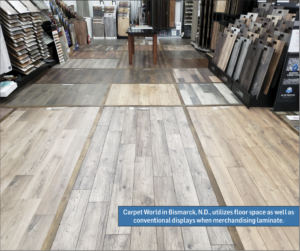By Nicole Murray
The various techniques used to merchandise laminate can have a direct correlation to product sales, observers say. Different showroom design tactics can be utilized to provide an easier shopping experience for customers as well as a more effective sales process for retail sales associates.
“It is an overwhelming process, and it is our job to simplify it,” said Rick Oderio, owner of Conklin Bros, San Jose, Calif. “Consumers can easily be inundated by the various amount of options, so it is important to narrow down their choices with clean, yet aesthetically pleasing displays.”
Listening closely to customer feedback is a huge factor in determining which products to display on the showroom floor. As Oderio explained: “At one time we brought in some inexpensive laminates, but our customer base made it clear that they want Mohawk products and the sales show for itself. The major manufacturers are successful for a reason, so relying on their visually appealing displays have proven to be a success.”
Pair like products together
Retailers suggest merchandising laminate products among similar categories as opposed to being placed next to competing segments like wood, because consumers are usually shopping for a specific visual as opposed to certain product types. “People are quicker to tell me the specific look they want but are commonly clueless of which overall product type best fits their situation,” said Fred Wee, owner of Interiors & Textiles, Palo Alto, Calif. His advice? “Let their lifestyle and desired price point determine product selection, and then use the information you have to make the best suggestions.”
Experts say laminate products should be displayed side by side so customers can visibly see and feel the difference between the various colors, patterns and textures available. “There are so many different options for various design capabilities, so having the products displayed side by side can help with narrowing down their final choice,” Wee explained. “For example, let them decide upon a color, and then browse the various textures and shades of the colors available. It is a visual process of elimination.”
Go big or go home
John Dauenhauer, owner of Carpet World in Bismarck, N.D., recommends dealers employ larger samples to give the consumers the opportunity to visualize how the product will appear in their own homes. “When people shop in our store, we want them to feel like they are experiencing the products as a preview to what it would be like to have it installed in their home,” he explained. “It all comes down to the visuals and what looks best. You need to give the consumers the tools to confidently make a choice.”
Making optimal use of wall space also conveys a professional presentation. Retailers say the tactic is a great space saver for smaller locations looking for a visually appealing alternative. “We have laminate samples all along a big wall in black trimming for a clean and simple look that offers an easy shopping experience for the customer,” Conklin Bros.’ Oderio explained.
Don’t forget about the floor
Beyond utilizing wall spaces and traditional merchandising units, retailers have also achieved positive results by installing product on the showroom floor. Case in point is Dauenhauer’s Carpet World, which installed a variety of brands, colors and styles along the walkway of their showroom floor leading up to the laminate displays.
“There is a huge advantage of actually seeing the product installed and in action along the walkway,” Dauenhauer explained. “The job of visualizing how the floor will look and feel in their own homes is being done for the customers, all while showing them how the product handles the everyday wear and tear unlike the products seen in the displays.”
Place it front and center
If space allows, retailers also recommend placing laminate displays as close to the entrance as possible, so they are in a high-traffic area. Experts say this serves the dual function of displaying the category prominently while demonstrating how the floors can withstand dirt, rain or even snow consumers might track in when entering.
“Laminate is a durable product with water-resistant options; when it is exposed to rain and dirt, the displays are showing customers the high wear and tear it can handle by seeing it in action,” Wee explained. “Customers need to see it to believe it.”
